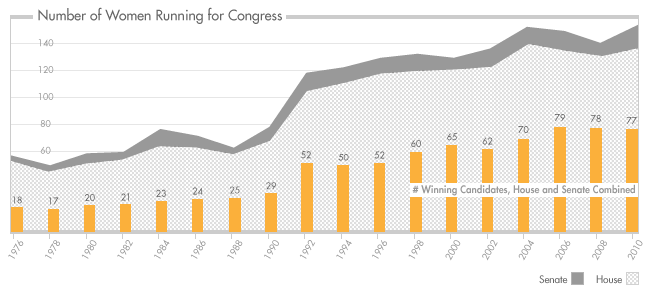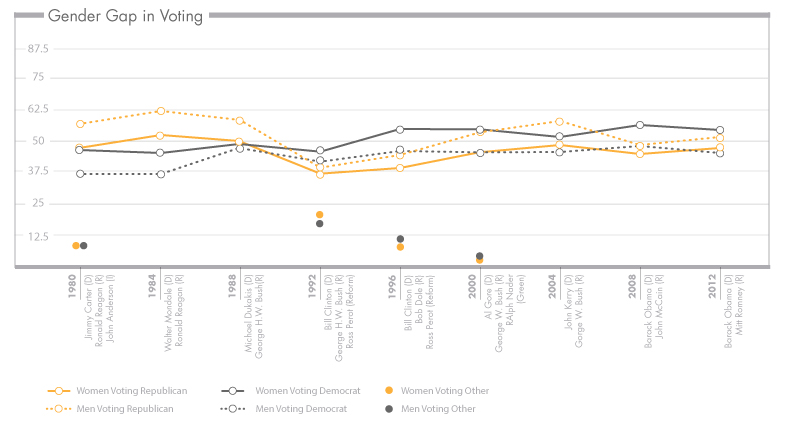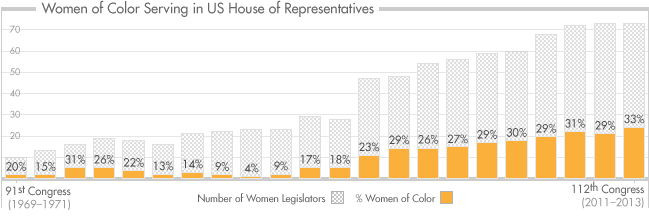Research Inventory
This inventory of current and past research in the field of women and American politics aims to identify strategies that can be used to elect more women and to determine whether there are important research questions yet to be addressed. The study was conducted by Rutgers Center for American Women and Politics.
Download Full Inventory
Women Candidates and Campaigns
While voters still hold gender stereotypes about men and women, they do not affect women’s ability to be elected to political office.

Summary
- Women and men are equally qualified to run for office. Overall, voters with more conservative beliefs are less likely to vote for a woman
- Incorrect beliefs about voters’ gender stereotypes often influence a female candidate’s campaign strategy
- More important than gender stereotypes are: incumbency, party label, and political issues
Details
Voter Stereotypes and Women’s Underrepresentation
- Women are as likely as men to win when they run, but they must be more qualified than a male candidate to be successful
- Gender, race, party, and geography influence electoral opportunity for women. For example, women of color are usually elected in majority-minority districts and Democratic women are more often elected in wealthy, urban, liberal, and diverse districts
Voter Attitudes and Women Campaigns
- Gender stereotypes still exist: voters believe women are better equipped to handle education and healthcare, while men are routinely considered experts on foreign policy and home defense
- Women’s gender stereotypes (caring, collaborative, community-oriented) are seen as less fitting for political office than male gender stereotypes (power-seeking, strong, combative)
- There is little evidence that voters penalize candidates based on gender stereotypes: party label and incumbency are more important than gender
- Studies found no evidence that voters based their decision on gender stereotypes in the 2006 US Senate election cycle
Campaign Strategy
- Only 25 percent of women work on federal and gubernatorial campaigns. These numbers could be increased
- Effective campaign strategies can neutralize gender stereotypes
Future Research
- Perceptions of sexism and gender stereotypes are preventing more women from running. More targeted resources are needed to combat these incorrect assumptions
- The field needs to know more about the interplay between partisanship and female candidates
- Little research has been done on the necessity of candidates’ prior electoral experience in local office in order to move on to higher office
- We need to understand how women candidates intersect with race, ethnicity, and sexuality in their campaigns
- Women engage with social media in campaigns differently than men. We need to understand the impact this has for future candidates
Further Reading
Women’s Election to Congress
Since Jeannette Rankin became the first woman in Congress in 1917, we have seen the number of women elected to Congress rise. The rise, however, has been very slow. Women make up only 19.3 percent of the House of Representatives and 20 percent of the Senate.

Summary
- The rise of women in Congress has been slow and not linear. In fact, the 2010 election saw a small decline in the number of women in Congress
- The US ranks 94th worldwide in terms of the number of women in the national legislature
- There is a partisan gap in politics: the Democratic Party has elected more women than the Republican Party: one third of Democrats are female, while only 10 percent of Republicans are women
- When women run, women win. The biggest barrier to women in politics is incumbency
- Since women candidates believe they must be overqualified before considering running, they are often of greater quality in terms of education and experience than their male counterparts
- Women friendly districts are more liberal, urban, educated, and diverse with higher levels of income
Details
Several factors explain the low number of women in Congress
- There are too few women running for political office in the first place
- The biggest barrier for women in politics is incumbency. Incumbents are still predominantly male and almost always win their reelection bid
- Female incumbents face more primary and general election challenges than male incumbents
- Women do better in open seat races: in 1992, a watershed year for women in politics, there were many open seats. This availability led to a four percentage point increase (from 6 percent to 10 percent) of women in politics. A total of 117 women ran and 53 women won that year
Women are often the better qualified candidates
- Women only run once they feel over-qualified for political office
- Women are more likely to have previous electoral experience before running at higher levels of office
- This suggests that women need to be more qualified than men to achieve the same electoral results
Women are more productive lawmakers
- Women bring more federal dollars back to their district
- Women (co)sponsor more bills than men
There are far more Democratic women in Congress than Republican women
- More PACs support Democratic women than Republican women
- Fewer Republican women run and win primary elections
- Republican women have a harder time winning primaries because they are incorrectly assumed to be too moderate by conservative voters
Future Research
- Underrepresentation of women of color in Congress
- Retirement issues and women’s congressional careers: succession planning
- Role of campaign funding: do escalating costs impede women’s ability to run?
Further Reading
Reaching Executive Office – the Presidency and the Office of the Governor
These positions are considered less likely to focus on misperceived ‘women’s issues’, such as education and healthcare.

Summary
- Currently, only 6 out of 50 governors are female and no woman has ever been president
- Historically, 99 countries have had a female head of state. 22 countries are currently being led by a woman. Some researchers argue that hereditary monarchy (Queens by birth) and welfare states (less emphasis on defense/military) are commonly used to explain why other countries have more female leadership
- Only two women have ever appeared on the presidential ticket, both as vice-presidents: Geraldine Ferraro (D) in 1984 and Sarah Palin (R) in 2008
Details
Voters support the idea of a female president
- 95 percent of voters would vote for a female president
- Numbers differ by partisanship and sex: Democratic women want to see a female president in their lifetime the most (69 percent) while Democratic men (46 percent), Republican women (20 percent) and Republican men (16 percent) are less supportive
Women running for the presidency
- Presidential candidates are typically former or current senators or governors. Historically, governors have been more successful in presidential races
- The low number of women in the Senate and Governorship (especially Republican women) severely limits the viable candidate pool for the presidency
Women and the Governorship
- Voters are less likely to see women as the ideal candidate for governor. This position is more likely linked to being ‘tough’. Voters are more comfortable electing women to legislative positions than to leadership positions
Further Reading
The Impact of Women in Elected Office
Increasing the number of women in elected office is always accompanied by the belief that women will better represent women’s issues (education, healthcare).

Summary
- Women have different legislative priories than men. Female lawmakers more often introduce bills dealing with women, family, and children
- Women of color represent both women’s issues and issues of concern to their respective minority group
- Cooperation among women legislators is made more difficult through polarization of parties
Details
Results are inconclusive if an increase in female politicians also leads to more women’s interests being represented in legislation.
- A critical mass (around 30 percent) of women is not necessary to be successful with legislation
- Women become more impactful when they form a caucus together
Legislatures as undesirable working environments for women
- Legislatures are still male-dominated and often women’s voices go unheard
- Access to leadership positions (i.e. committee placements) are more difficult for female than male legislators
Collaboration Among Women
- Collaboration among women is made difficult by party affiliation due to increased polarization between parties
- Previously, women in the House were able to find more areas of common ground in the Congressional Caucus for Women’s Issues. Recently, this has been more difficult
- In the Senate, bipartisan and collaborative efforts continue among the women senators
Future Research
- How do women navigate legislatures in the face of polarization and are they able to continue to cooperate despite these challenges?
- How do gender and race intersect in shaping the legislative priorities of female lawmakers?
- How should the field define women’s interests and issues without contributing to stereotypes?
Further Reading
Media Coverage of Women Candidates
Women receive as much media coverage as male candidates; however the press is often sexist

Summary
- Media remains sexist towards female candidates
- Female lawmakers use Twitter more than their male counterparts
Details
Coverage of female candidates and officeholders.
- Media focuses more on appearance, personality, and family life of the candidate than male candidates
- More attention is given to women’s engagement with perceived “women’s only” legislation creating a false appearance that women have a narrow focus
- Media coverage dissuades more women from running for office than men
- Female lawmakers receive less traction in the media in terms of being quoted across media outlets
Women and Presidential coverage
- Media reinforces the idea that the president should be male
- The media typically covers female presidential candidates as less serious candidates or as novelties
Today’s media environment
- 40% of all bylines and on-camera appearances are by women
- 33 percent of guests on political morning shows are female
Future Research
- How does media coverage differ across types of office, party, race and ethnicity, and incumbency of candidates?
- How does media coverage affects voter evaluation of candidates?
Further Reading
Money and Women Candidates
Women raise as much money as men but must work harder.

Summary
- Fundraising is more difficult for women than men
- Women give less money to political campaigns then men and in smaller amounts
- Women PACs are well developed on the Democratic side (EMILY’s List) but less influential on the Republican side
Details
Women as Fundraisers
- Women PACs are crucial to help women succeed
- Women receive more individual, small amount donations (under $200) than men. This means they have a broader support base but are less likely to have big money supporters. Greater efforts are required to raise the same amount of money
- PACs led by men give less money to female candidates than male candidates
- Women seem to be less comfortable asking for money than men. Fundraising is a deterrent for women when deciding to run for office
- Lack of PACs run by women aimed at female Republican candidates makes it more difficult for them to establish financial credibility early in the race
Women as Donors
- Women give less often and in smaller amounts to political campaign
- Democratic women are more likely to give to female candidates than Republican women
- Women are less likely to be donors on a large scale
Future Research
- How often do women decide not to run after encountering initial fundraising difficulties?
- How do voter beliefs about the effectiveness of women in politics affect a candidate’s ability to fundraise?
- More focus should be placed on the primary stage because of the higher hurdles women face
- Are campaign contributions more helpful at certain junctures of a campaign?
Further Reading
Women Candidates and Political Parties
The underrepresentation of women in party leadership negatively affects the ability of political parties to recruit more women to run for office.

Summary
- Women and men have different social networks to tap for resources
- Women are more likely to run if they are recruited
- Globally, political parties have established electoral gender quotas which increased the number of women in politics substantially
- There are more women in elected office in the Democratic versus the Republican Party
Details
Women and Party Leadership
- A woman has never chaired a national party
- Neither party has ever elected a woman as Senate leader
- Only 16 women currently lead the chambers in state legislatures
Parties and Recruitment
- Women feel that party leadership discourage them from running for office
- Studies show that in states with strong party roles, fewer women are present in politics
- Some party leaders believe that women are less competitive than men as candidates
Partisan Gender Gap
- 16.9 percent of Republican state legislators are women, compared to 33.8 percent of Democratic women
- Non-incumbent Republican women are less likely to win than their male counterparts
- Republicans are less likely to see women as a good fit for political life
Future Research
- More data is needed on politics at the local level and how this contributes to women starting out in politics
- Women’s access to party leadership roles
- What is the internal decision-making process of parties around recruitment strategies and decisions?
Further Reading
Women as Voters
Women vote more often than men and prefer Democratic over Republican candidates.

Summary
- 10 million more women voted in 2012 than men
- Gender gap = the difference in how women and men vote
- Since the 1980s, women have been more likely to vote than men in every election
Details
Gender Gap
- Women are more likely than men to support Democratic candidates
- Women are more likely than men to identify as Democrats
- Women were more likely (by 10 points) to vote for President Obama in 2012 and prefer Democrats (by 10 points) in the 2014 House election cycle
Explanation for Gender Gap
- Women prefer active role for government including stronger social provisions
- Women are less likely to support military interventions
Differences Among Women
- Unmarried women and women of color are more likely to vote Democratic than married women or non-Hispanic white women
- Latinas are more Democratic-leaning than Latinos
Women supporting female candidates (gender affinity)
- Women are not necessarily more likely than men to support female candidates
- Female voters are more concerned with the lack of women in office and Democratic women particularly want to see a female president in their lifetime
- Party identification is a better predictor of voter choice than gender
- There is a political knowledge gap: women tend to be less informed about politics than men
Future Research
- How does voting behavior in primary elections differ between men and women?
Further Reading
Candidate Recruitment and Women’s Routes to Office
Women are less likely to run for office than men and need to be asked to run.

Summary
- The candidate pool of women (law, business, and political activism as stepping stones to political office) is now equal in representation to men but women are still more reluctant to run than men (political ambition gap)
Details
Ambition Gap
- Women are less likely to express interest in running for office
- Women are less likely to want to run for national office
- Women, even when qualified, do not perceive themselves as so
- Women don’t consider politics a good career choice for social change
Political Recruitment
- The majority of female state legislators had not previously considered running for office until someone asked them to run
- Women need more encouragement compared to men
- Parties are important gatekeepers to political office: they can encourage more women to run or prevent women from running
- Women’s groups and women-focused PACs have identified, trained, and supported women candidates for a long time
New data shows that women are more ‘election averse’ than men, which suggests that women often don’t run for office because they dislike the campaign process
Future Research
- What is the identification process of candidates by the media, PACS, parties, and interest groups?
- What level of recruitment and support resources are needed for women candidates to full comfortable before running?
Further Reading
- Read our full report
- Training Organizations:
Women of Color in American Politics
Women of color face a double-disadvantage because they have to overcome gender and racial stereotypes. However, they have an easier time being elected to legislative as opposed to executive office.

Summary
- One in every three Democratic women state legislators are women of color
- Two out of three Republican women governors are women of color
- In 2015, 33 women of color in Congress, nine in statewide executive office, 390 in state legislatures
- Women of color are only 2.8 percent of all statewide elective executives
- African American women represent the majority of women of color in politics
- Women of color are more likely to be Democrats than Republicans
Details
Women of color are most likely to be elected in majority-minority districts
Women of color are confronted by disadvantages that serve as double-edge swords
- African American women have a harder time at fundraising
- However, women of color can also appear to a broader group of people, tapping both into community of colors and women for support
Women of color have unique policy perspectives as officeholders
- African American women in particular offer much needed insight in the areas of health care, education, and economic development as it effects their communities
- African American women sponsor both black-centric interest and women’s issue bills
- Latinas feel a greater need to represent multiple minority groups
Women of color are commonly excluded from traditional power structures within states and might have less influence once they are elected
Future Research
- Broad research on the experiences of women of color regarding candidate emergence, primary election experience, and fundraising
